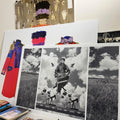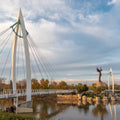Dorothea Lange's 'Death of a Valley' photographs on view at Booth Western Art Museum
By Chadd Scott on
Agriculture is a $50-plus billion business in California, greater than any other state, nearly double that of its nearest competitor, Iowa. Grapes, milk, cattle, almonds, oranges, pistachios, tomatoes. More than 24,000,000 acres of the Golden State are covered by almost 70,000 farms, nearly a quarter of its landmass. California creates almost 13% of all agricultural production in the United States, making it the fifth largest supplier of food and wearable textiles in the world by itself.
All those farms and ranches and crops need water. Billions of gallons of water. Without irrigation, California’s agriculture industry would go belly up within weeks. Almost 10 million acres of farmland in California is irrigated with roughly 34 million acre-feet of water a year; an amount that would cover 31 million football fields with one foot of water.

Pirkle Jones, ‘Dorothea Lange Photographing the Destruction of a California Landmark,’ from ‘Death of a Valley,’ 1956, 8 x 10.” Selenium Toned Silver Gelatin Print © Regents of the University of California, Courtesy of Special Collections & Archives. University Library, U.C. Santa Cruz. Ruth-Marion Baruch and Pirkle Jones Photographs and Papers.
The state’s 40 million residents need water too. Billions of gallons of water. An increasing amount of it for an increasing population.
California relies on a combination of surface water and groundwater sources to meet its gargantuan water needs, having developed a complex network of manmade infrastructure over the past century to do so. California has 1,400 dams, two of the largest water storage and transport systems in the world – the Central Valley Project (CVP) and State Water Project (SWP) – and some of the largest reservoirs in the country. The state has been called “the most hydrologically altered landmass on the planet.”
Water is life everywhere, in California, it feels much more important than that.
Not surprisingly, water has been a critical concern – the critical concern – for the state nearly since its incorporation in 1850. You’ve seen “Chinatown,” haven’t you? What many consider the greatest screenplay in Hollywood history starring Jack Nicholson centers on a murder related to water use in Los Angeles.

Pirkle Jones, ‘Town of Monticello Early Spring 1956,’ from ‘Death of a Valley,’ 1956, 16 x 24,” Selenium Toned Silver Gelatin Print. © Regents of the University of California, Courtesy of Special Collections & Archives. University Library, U.C. Santa Cruz. Ruth-Marion Baruch and Pirkle Jones Photographs and Papers.
Politics, acrimony, controversy, money, and influence flow through the water in California as surely as two parts hydrogen and one part oxygen. That mixture was examined by photographers Dorothea Lange (1895-1965) and Pirkle Jones (1914-2009) in 1956 when Lange convinced “Life” magazine to commission a photo essay documenting the last year of the Berryessa Valley, including the town of Monticello, roughly 80 miles northeast of San Francisco. The entire area was due to be submerged with the opening of the Monticello Dam, and the creation of Berryessa Lake, to provide water for irrigation and recreation.
Death of a Valley
The damming of Putah Creek was first proposed in 1907. For the next five decades, residents fought plans to build the dam that would turn their valley into a lake. Government officials in neighboring counties and at the state and federal level insisted the dam was necessary to provide water to the rapidly growing state.
As Valley residents who had long opposed the dam were being forced out of their homes, Lange and Jones spent the year photographing throughout the Valley. Memorable scenes included poignant events such as the town’s last Memorial Day, the final cattle round-up, and the last harvesting of crops.
“It was like Eden in America,” Jennifer McFarland, Jones’ longtime friend, assistant, and archivist said of the Berryessa Valley – one valley over from Napa – before the dam. “It was a very fertile valley. They never had a crop failure. They grew wheat and had orchards producing pears and grapes, there was a lot of cattle ranching. A very idyllic existence.”
That idyllic existence was wiped away in creating 23-mile-long, 3-mile-wide, Lake Berryessa.
“The people in this valley always thought the government was going to be on their side,” McFarland said. “They were in disbelief that this had happened to them and when they were thrown out, none of these people were ever able to regain the kind of lifestyle they had in this beautiful valley. People were interviewed in the mid-90s who had come from this and they said they never recovered and how painful it was. They never regained the footing that they had.”
An article in the Alta Journal, a literary journal celebrating the culture, personalities, and history of California and the West, included a quote from a fourth-generation rancher in the Valley who saw his family uprooted.
“You just didn’t think they’d take all that away, but they sure as hell did,” he said. “It still bothers me… I mean, we were mostly all related, cousins and uncles and aunts, and everybody was just kind of on their own. Some of them I never saw again.”

Pirkle Jones, ‘The Graves Have Been Disinterred, Monticello Cemetery is Moved to Higher Ground,’ 1956, 15 x 15.” Selenium Toned Silver Gelatin Print. © Regents of the University of California, Courtesy of Special Collections & Archives. University Library, U.C. Santa Cruz. Ruth-Marion Baruch and Pirkle Jones Photographs and Papers.
Most striking among Lange and Jones’ photographs are the images of graves being dug up so bodies could be relocated, only the empty holes remaining. The photographers were also there when heavy machinery and government workers arrived to strip the valley of buildings, landmarks and vegetation.
“There are photographs of the complete evisceration and destruction of this valley where basically everything was cut down to within six inches,” McFarland explained. “Homes were burned or relocated or destroyed. All these majestic oak trees that were over 100-feet-tall, cut to the ground. It looked like a war site when they were done.”
The final images show the valley filling with water.
See for yourself during the Booth Western Art Museum in Cartersville, GA’s presentation of “Dorothea Lange and Pirkle Jones: Death of a Valley,” on view through June 9, 2024.
“If this (story) doesn't touch your heart, you are not alive,” McFarland said. “If you can go and see this exhibition and not feel a tear, or pain about this, you're not upright.”
Dorothea Lange and Pirkle Jones
As one of the most prominent American photographers of the 20th century, Lange needs little introduction. Her Migrant Mother may be the most recognizable photographic image ever taken.
Jones, on the other hand, will be unfamiliar to most.
He moved to northern California in the mid-40s, attending the first class offered in photography at the California School of Fine Arts which would become the San Francisco Art Institute. The professor was Ansel Adams.
He would study not only with Lange, but other famed photographers including Imogen Cunningham and Edward Weston. He later taught at the school for many decades.
“Pirkle always was curious about the world and interested in what was going on, fun to be around, someone who enjoyed his life and what he was doing and loved photography and had the good fortune to be a photographer,” McFarland said.
He lived in Mill Valley and the majority of his photographs were taken within 45-mile-radius of his home, including “Death of a Valley.”
“At that point in time, dams represented progress,” McFarland said. “Dorothea found out about this and felt that she wanted to document (the Berryessa Valley) before and after. What were the costs for the community and the displaced residents?”
When Lange received the commission from “Life” to shoot the Valley, Adams suggested Jones as a collaborator and since Lange was already acquainted with Jones, the invitation was sent and accepted.
“The Berryessa Project was one of the most meaningful photographic experiences of my professional life,” Jones said. “When Dorothea Lange, a friend, and colleague, invited me to collaborate on this project with her in 1956, I looked forward to the experience.”
Both Lange, obviously, as evidenced from her work during the Dust Bowl, and Jones, infused their photography with heavy doses of social commentary.
“Pirkle felt that as soon as you picked up your camera and took a photograph that you were making a political statement,” McFarland explained.
Unfortunately, the magazine got cold feet.
Government destruction of a small town in the name of so-called “progress” and the displacement of its 250-odd residents wasn’t what the flag-waving magazine was interested in highlighting during the nation’s post-war glory years of Buicks and babies. “Life” killed the story.
Jones thought the magazine passed in favor of covering a flood in Texas according to McFarland, but she thinks, “‘Life’ did not want to share this portrayal of the loss and social costs to build this dam and the destruction.”
Fortunately, Lange and Jones retained rights to the images.
In 1960, the photographic journal of the Aperture Foundation published thirty of the photos as an essay entitled “Death of a Valley.” These photographs were then exhibited at the San Francisco Museum of Modern Art, Oakland Museum and later at the Art Institute of Chicago. Since then, the project has been largely forgotten. The Booth Museum exhibition will include over 80 images, most having never been exhibited before.
“They worked so well in collaboration,” McFarland said. “Their work provided a balanced and sincere presentation of the valley's demise. They had a lot of sympathy for the people who were being displaced.”
Little known about the project’s production, or Lange’s life in general, are the physical obstacles she overcame.
“Dorothea was very ill during this time with a temperature of 102,” McFarland said of Lange who battled chronic sickness and pain much of her life. “Pirkle had concerns about how she was doing. and would she hold up for this because she was so ill and just so frail.”

Pirkle Jones, ‘Dorothea Lange in McKenzie’s Store,’ 1956, 8 x 10. ” © Regents of the University of California, Courtesy of Special Collections & Archives. University Library, U.C. Santa Cruz. Ruth-Marion Baruch and Pirkle Jones Photographs and Papers.
Echoes
What happened in the Berryessa Valley happened elsewhere. It happened in Yosemite to the Hetch Hetchy Valley. It happened in Alabama. Places wiped off the map for dams and flood control and irrigation and electricity. “Progress.”
“Death of a Valley’s” nearly 70-year-old story echoes in contemporary issues including water policy, private property rights, land conservation, and local governance vs. state and federal jurisdiction. California continues to be the epicenter for them all.
“This fight is still going on,” McFarland, who lives in Northern California, said. “It's a timeless issue: what price progress and what price when you're producing all these crops.”
Oil pipelines can be seen as the dams of the 21st century, corporations and the federal government teaming up to steamroll local communities. The Berryessa Valley in the 1950s, the Standing Rock Sioux Reservation in the 2010s.
“It's very hard to stop big government and I think telling the story is part of how things change,” McFarland said. “I think the (Berryessa Valley) residents had a certain naivete about who they were in the world… and I think today people are better informed, I hope.”
Any lack of naivete and greater information possessed by people placed in the same corporate and governmental crosshairs today as the residents of Monticello were owe that awareness to the predecessor communities. The communities who never thought it could happen to them. The communities who saw their interests were overpowered by corporate interests. And the photographers and journalists who brought those stories to light.



